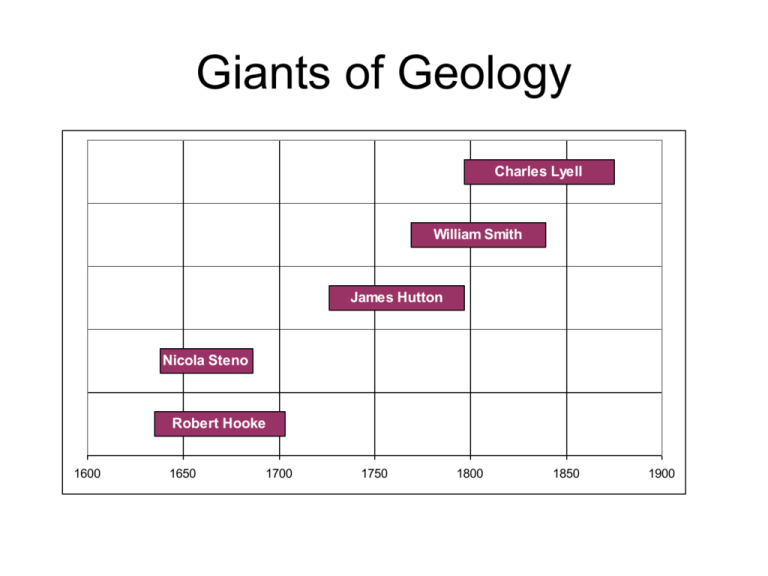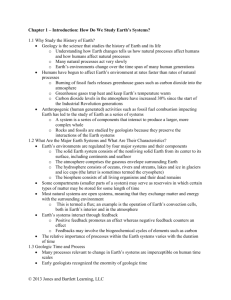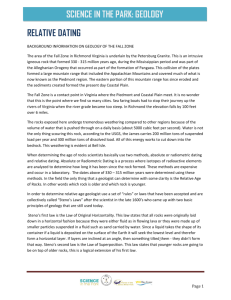Nicola Steno – 1638 - 1686 - Geological & Mining Engineering
advertisement

Giants of Geology Charles Lyell William Smith James Hutton Nicola Steno Robert Hooke 1600 1650 1700 1750 1800 1850 1900 Nicola Steno – 1638 - 1686 1669-Niels Stensen (Steno) publishes Forerunner, showing diagrammatic sections of the Tuscany area geology, making the important point that sediments are deposited in horizontal layers. Steno’s Laws Steno's law of superposition: layers of rock are arranged in a time sequence, with the oldest on the bottom and the youngest on the top, unless later processes disturb this arrangement. It is Steno's most famous contribution to geology. Steno's principle of original horizontality states that rock layers form in the horizontal position, and any deviations from this position are due to the rocks being disturbed later. Steno essentially abandoned science after his conversion to Roman Catholicism in 1667, much to the dismay of some of his scientific colleagues. He was ordained as a priest in 1675. In 1677, he became a titular bishop, and spent the rest of his life ministering to the minority Roman Catholic populations in northern Germany, Denmark, and Norway. Nicola Steno – Fossils While examining the teeth of the shark, Steno was struck by their resemblance to certain stony objects, called glossopetrae or "tongue stones," that were found in certain rocks. Ancient authorities, such as the Roman author Pliny the Elder, had suggested that these stones fell from the sky or from the moon. Others were of the opinion, also going back to ancient times, that fossils naturally grew in the rocks. Steno's contemporary Athanasius Kircher, for example, attributed fossils to a "lapidifying virtue diffused through the whole body of the geocosm." Steno, however, argued that glossopetrae looked like shark teeth because they were shark teeth, that had come from the mouths of once-living sharks, and come to be buried in mud or sand that was now dry land. Robert Hooke (1635-1703) No portrait survives of Robert Hooke. His name is somewhat obscure today, due in part to the enmity of his famous, influential, and extremely vindictive colleague, Sir Isaac Newton. Yet Hooke was perhaps the single greatest experimental scientist of the seventeenth century. His interests knew no bounds, ranging from physics and astronomy, to chemistry, biology, and geology, to architecture and naval technology; he collaborated or corresponded with scientists as diverse as Christian Huygens, Antony van Leeuwenhoek, Christopher Wren, Robert Boyle, and Isaac Newton. Among other accomplishments, he invented the universal joint, the iris diaphragm, and an early prototype of the respirator; invented the anchor escapement and the balance spring, which made more accurate clocks possible; served as Chief Surveyor and helped rebuild London after the Great Fire of 1666; worked out the correct theory of combustion; devised an equation describing elasticity that is still used today ("Hooke's Law"); assisted Robert Boyle in studying the physics of gases; invented or improved meteorological instruments such as the barometer, anemometer, and hygrometer; and so on. He was the type of scientist that was then called a virtuoso -- able to contribute findings of major importance in any field of science. It is not surprising that he made important contributions to biology and to paleontology. Robert Hooke (1635-1703) Hooke examined fossils with a microscope -the first person to do so -- and noted close similarities between the structures of petrified wood and fossil shells on the one hand, and living wood and living mollusc shells on the other. In Micrographia he compared a piece of petrified wood with a piece of rotten oak wood, and concluded that “this petrify'd Wood having lain in some place where it was well soak'd with petrifying water (that is, such water as is well impregnated with stony and earthy particles) did by degrees separate abundance of stony particles from the permeating water, which stony particles, being by means of the fluid vehicle convey'd, not onely into the Microscopical pores. . . but also into the pores or Interstitia. . . of that part of the Wood, which through the Microscope, appears most solid. . . “ Hooke had grasped the cardinal principle of paleontology -- that fossils are not "sports of Nature," but remains of once-living organisms that can be used to help us understand the history of life. Hooke realized, two and a half centuries before Darwin, that the fossil record documents changes among the organisms on the planet, and that species have both appeared and gone extinct throughout the history of life on Earth. Robert Hooke (1635-1703) 1668-Robert Hooke presents a lecture to the Royal Society claiming that earthquakes, not the biblical flood, have caused fossils to be found on mountaintops and buried in stone. Perhaps his most famous microscopic observation was his study of thin slices of cork, depicted above right. In "Observation XVIII" of the Micrographia, he wrote: . . . I could exceedingly plainly perceive it to be all perforated and porous, much like a Honey-comb, but that the pores of it were not regular. . . . these pores, or cells, . . . were indeed the first microscopical pores I ever saw, and perhaps, that were ever seen, for I had not met with any Writer or Person, that had made any mention of them before this. . . Hooke had discovered plant cells -- more precisely, what Hooke saw were the cell walls in cork tissue. In fact, it was Hooke who coined the term "cells": the boxlike cells of cork reminded him of the cells of a monastery. William Smith (1769-1839) Fossils have been long studied as great curiosities, collected with great pains, treasured with great care and at a great expense, and shown and admired with as much pleasure as a child's hobby-horse is shown and admired by himself and his playfellows, because it is pretty; and this has been done by thousands who have never paid the least regard to that wonderful order and regularity with which nature has disposed of these singular productions, and assigned to each class its peculiar stratum. William Smith, notes written January 5, 1796 William Smith (1769-1839) Smith observed that the fossils found in a section of sedimentary rock were always in a certain order from the bottom to the top of the section. This order of appearance could also be seen in other rock sections, even those on the other side of England. As Smith described it, . . . each stratum contained organized fossils peculiar to itself, and might, in cases otherwise doubtful, be recognized and discriminated from others like it, but in a different part of the series, by examination of them. This is a statement of the "principle of faunal succession." 1815-Relying largely on fossils to identify strata, civil engineer William Smith publishes a geologic map of England, Wales and part of Scotland, the largest region so far documented. Four years later, Smith will be arrested and sent to debtors' prison. William Smith (1769-1839) In 1796, Smith was elected to the agricultural society at Bath, and began to discuss his ideas with others who were interested in rocks and fossils. He began to write notes and draw up local geologic maps. Smith was not the first to make geologic maps, but he was the first to use fossils as a tool for mapping rocks by their stratigraphic order, and not necessarily by their composition. Previous mapmakers had attempted to use the composition of rocks as indicators of their position in the stratigraphic column. William Smith (1769-1839) In 1799, Smith's employment with the canal-building firm came to an end. Smith then took a series of engineering jobs in several parts of Britain, and made a number of side trips all over England and Wales. His goal was to produce a complete geologic map of England and Wales, using the principles of fossil succession. Progress was slow, and money to finance the publication of such a map was hard to find. Finally, with the aid of 400 subscribers underwriting the project, production of the completed map began in 1812, and in 1815 the map was finally published. James Hutton 1726 - 1797 • In the late 18th century, the educated world clung to the Neptunian theory of the earth proposed by Abraham Gottlob Werner. Known as the father of geology, James Hutton overturned the Neptunian orthodoxy and instead proposed his own Plutonian theory. In the rocks of Scotland, Hutton found fingers of granite reaching well into sedimentary rocks, and saw this as evidence of subterranean fire and heat. He also found neatly deposited layers of sedimentary rocks overlaying rock layers that were almost vertical, as shown at right. The lower layers of rock, he concluded, must have been deposited eons before, then later upturned. In them, Hutton saw evidence of vast expanses of time in earth's history. (Charles Lyell was following in Hutton's footsteps when he wrote his own masterwork in 1830.) James Hutton 1726 - 1797 • 1794-James Hutton publishes An Investigation of the Principles of Knowledge. Buried in the 2,138-page philosophical tome is a chapter about variety in nature in which Hutton anticipates Charles Darwin's theory of natural selection. • 1795-James Hutton overturns the "Neptunian" view of rock formation in his Theory of the Earth, suggesting instead that forces of rock creation are balanced by forces of rock destruction. Charles Lyell 1797 - 1875 In August 1838 Lyell published the Elements of Geology, which, from being originally an expansion of one section of the Principles, became a standard work on stratigraphical and palaeontological geology. This book went through six editions in Lyell's lifetime (some intermediate editions being styled Manual of Elementary Geology), and in 1871 a smaller work, the Student's Elements of Geology, was based upon it. His third great work, The Antiquity of Man, appeared in 1863, and ran through three editions in one year. In this he gave a general survey of the arguments for man's early appearance on the earth, derived from the discoveries of flint implements in postPliocene strata in the Somme valley and elsewhere; he discussed also the deposits of the Glacial epoch, and in the same volume he first gave in his adhesion to Darwin's theory of the origin of species. A fourth edition appeared in 1873. Charles Lyell 1797 - 1875 • “Catastrophism,” was attacked in 1830 by a British lawyerturned-geologist named Charles Lyell (1797-1875). Lyell started his career studying under the catastrophist William Buckland at Oxford. But Lyell became disenchanted with Buckland when Buckland tried to link catastrophism to the Bible, looking for evidence that the most recent catastrophe had actually been Noah’s flood. • “Lyell wanted to find a way to make geology a true science of its own, built on observation and not susceptible to wild speculations or dependent on the supernatural. Timeline of Evolutionary Thought This slide shows the history of evolutionary thought from 1700 to the present in terms of the life spans of the principal figures involved. Note that some geologists are included here. This would be a suitable topic for a class paper, treating either the entire timeline shown to the left or selected parts. The internet and the library at the back of the lecture room (Dow 615) are good resources. The url at the bottom of the page is for the Berkeley site from which the figure is taken. This is a good site to visit and study, one of the best in the world and suitable even for high school students and laymen. http://www.ucmp.berkeley.edu/history/evotmline.html







